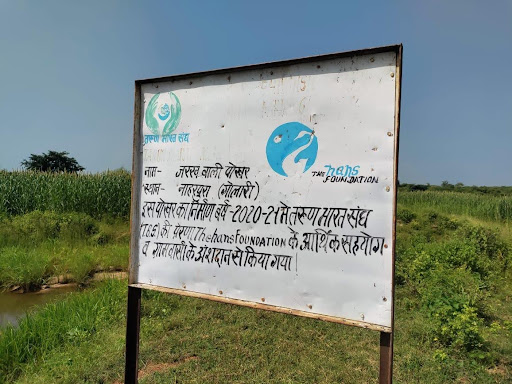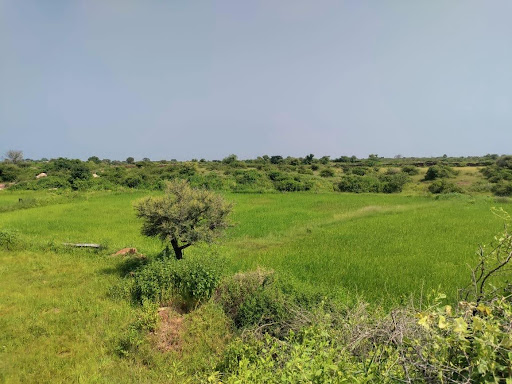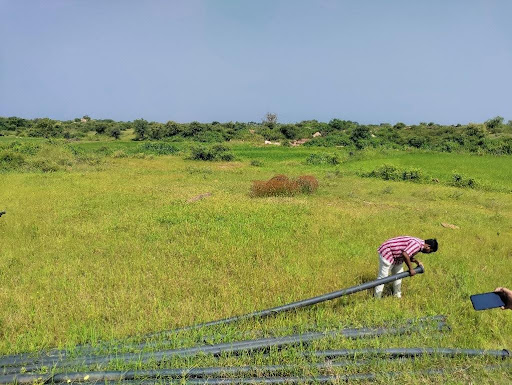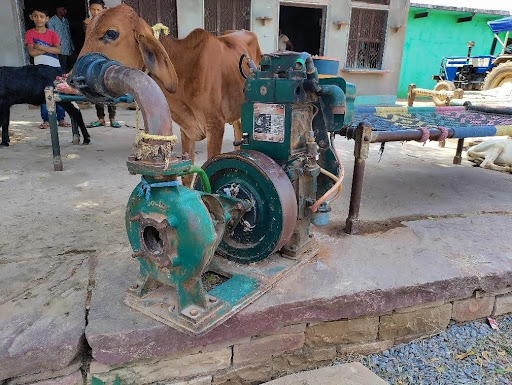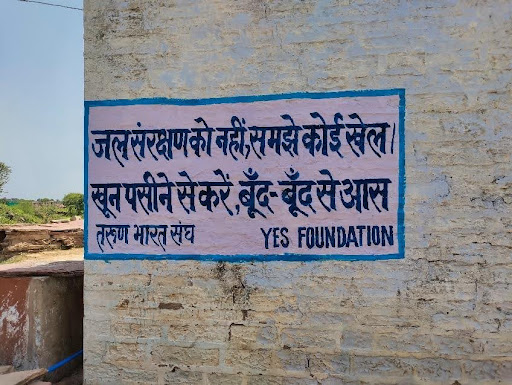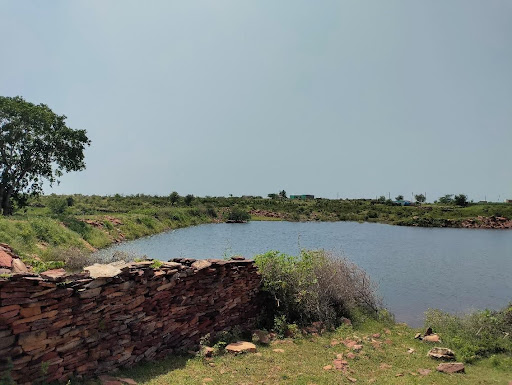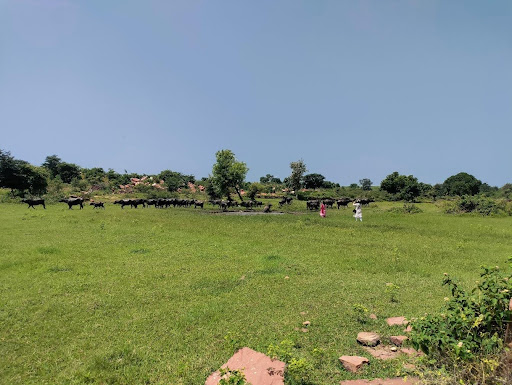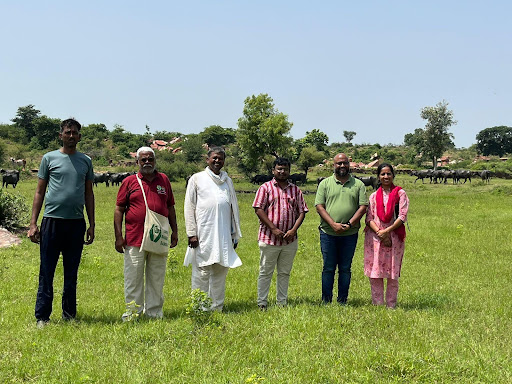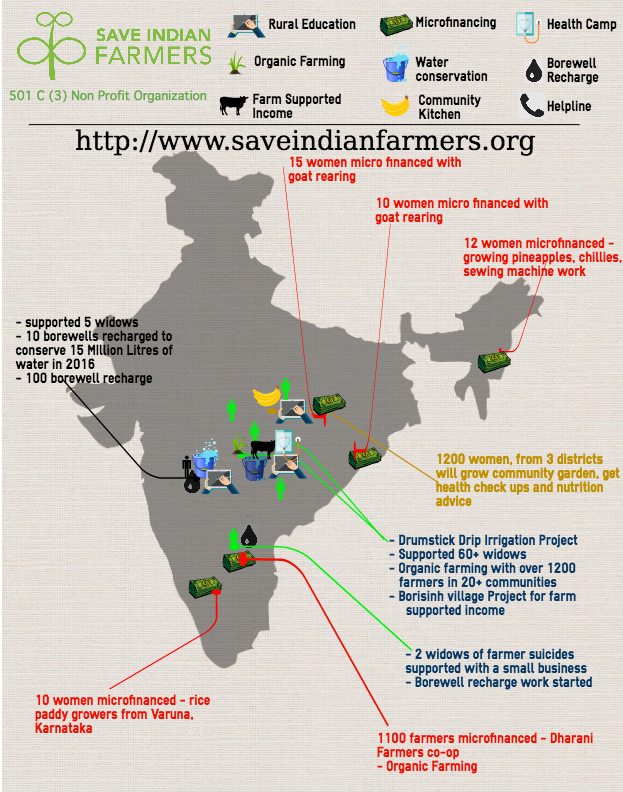Action-Programme Name-To learn about the work of the Tarun Bharat Sangh.
Overview
The population of Choriya-Khata is mainly engaged in agriculture and animal rearing (98%).The main source of irrigation in the region is groundwater that is fast depleting. The village face massive consequences of water scarcity. Their fields are parched, cattle thirsty and lives of women is an endless quest for water. Girls drop-out of schools to take care of the household chores while their mothers spend 4 to 6 hours every day in search of water. Tarun Bharat Sangh along with the villagers of Choriyakhata walked around the village and identified potential locations for construction of RWHS during community meetings. Both men and women, stakeholders of the village and indirect beneficiaries were involved during decision making process.
To ensure agricultural water security and ecosystem restoration, TBS plans to construct 02 rainwater harvesting systems in the
proposed village of Karauli in Rajasthan. 01 Rainwater Harvesting Structures is under construction. This Pokher will help in recharging the groundwater which will ensure drinking water round the year by directly benefiting 4 families and indirectly 35 families. The rainwater harvesting structures will help in providing water for irrigation during Rabi and Kharif seasons.
What does the Tarun Bharat Sangh do?
Tarun Bharat Sangh is a well-known Indian NGO that has been working since 1975 to reduce and adapt to climate change by promoting water conservation, sustainable agriculture and rural development in the arid and semi-arid regions of India. We are deeply rooted in the philosophy of Gram Swaraj. The Tarun Bharat Sangh, led by Waterman Rajendra Singh, works to spread awareness and importance about water.
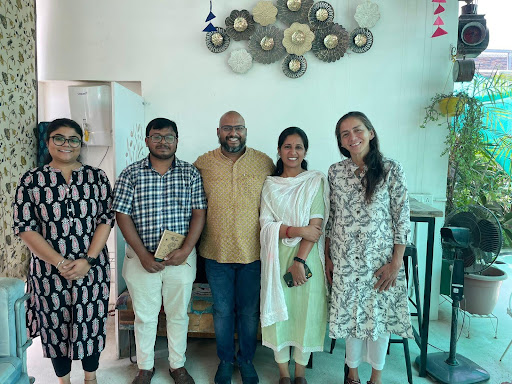
A meeting was held at the Jaipur office of Tarun Bharat Sangh. From left, Arnima Jain, Representative of Save Indian Farmers Foundation Prafulla Sutar, Executive Director of Tarun Bharat Sangh Maulik Sisodia, Social Media Manager Pooja Bhati, Barbecie in Chile Country
The work done to date and the results there of:
- 13 Rivers and streams have come back to life.
- 21+ national level jal yatras have been taken out.
- The water community has 100+ dedicated members (jal biradari).
- There have been 101+ save the river campaign.
- Reached out to 1000+ schools/colleges/universities through water awareness campaign.
- Trained 2000+ river volunteers through Know Your Rivers (Aao Nadi Ko Jaane).
- 5000+ Water Council
- 14000+ Rain Water Harvesting Structure (Johad/Pokhar/Pazar Lake)
Background of Bidarpur and its farmers
Bidarpur is a small village/settlement in Bari tehsil of Dholpur district in the Indian state of Rajasthan. It comes under Bidarpur Panchayat. It is located in Bharatpur division. It is located 26 km west of Dholpur district headquarters Dholpur. 216 km from the state capital Jaipur. Bidarpur has a total population of 662 and a household population of 115. Female literacy is 45.9%, literacy rate is 42.3%, and female literacy rate is 13.0%.
Bidarpur is a small village of 215 hectares in Baseri tehsil of Dholpur district, also known as the red stone land in the Indian state of Rajasthan. The village is administered by the sarpanch elected by the representative of the village through local elections. Bidarpur depends on the nearest town bari for all major economic activities. Villagers also draw water from some natural water sources such as two canals and two springs. Bidarpur is also surrounded by two lakes. The population of the village depends on drinking water sources and hand pumps in summer. The area of Bidarpur is divided into 1.3 hectares irrigated area, 49 hectares irrigated area, 39 hectares under cultural waste (including gauchar and 26 hectare area), the rest is available for cultivation.there is no land for cultivation
Report Observations
-
- At Naharpura in Dholpur district (on the jurisdiction of Bidarpur), Johad means Pazar Lake in local language. It is also called Pokhar in some places in Rajasthan. Around 40-50 farmers benefited from the water.Farmers can grow two rainy and summer crops. There is so much water in this pond.
- It takes two to three months to build this hole. In this, the work is started by selecting the place, village meeting, gram panchayat resolution, rules and conditions. The land for construction of Pokhar is selected only when the farmers who have the land for making the pokhar are contracted for the water required for the cultivation of other farmers.
- The water capacity of this pond is at least 10 crore liters-60 crore liters. Now, after harvesting maize and rice, wheat, pulses (tur, moong and matki) are planted in the rabi season.
- A pond/water pond drain (when there is a rock on one side to prevent water from overflowing, or when the char is removed 33 percent below the height of the total dam from the top of the dam by pitching the stone) is removed from one side of the lake at a height of 33 percent.
- It takes one to two months to build a pond.’ It is solely the responsibility of the Yuva Bharat Sangh and the farmers of the village to build it and, more importantly, its maintenance is also done by the farmers themselves by collecting money and making resolutions from the funds of the village gram panchayat.
The agriculture seen in the above photo is done on the waters of this pokhar. He currently cultivates corn, rice and mustard. Now, farmers grow three crops on the water.Last year, farmers earned 160 quintals of sarso and 100 quintals of wheat.He also planted fodder crops. He earns Rs. 50,000 from this fodder crop and sells fodder for cattle to other people in the village.Today, there is water, so it’s all green. Due to this water, the farmer has started living in the village since the formation of this pokhar, the youth have started living in the village itself after the water started accumulating. It has helped reduce migration.
- The pipes seen in the above photo are used to supply water from this Johad/Pokhar to agriculture. They didn’t use a sprinkler set.
- The diesel engines in the above picture are used to supply water from Johad to agriculture. Due to lack of electric poles and electricity facilities in the area, people here use diesel engines to water agriculture.
- In collaboration with Yes Foundation, similar slogans have been written on the walls of houses as well as on public walls to create awareness about water in villages and villages.
- Johad/Pokhar/Pazar Lake
The photo below shows the new site of Pazar Lake/Johad/Pokhar. Where it can be a lake. Tarun Bharat Sangh activists have been excellent at technical aspects for years while selecting this site. So those same people choose this site. When selecting the site, the agricultural site and the majority of farmers choose the same place for the lake as those who farm around them. The buffaloes you can see in the above photo are sitting in a water tank. Now that it’s monsoon season, the picture is visible.But in the summer, the animals do not have water to drink, so the animals suffer a lot, due to lack of water for agriculture, the farmers take only one crop in a year. That too if it rains, otherwise farmers do not get any income from agriculture.
- Agriculture using the water from Pokhar
- Prafulla Sutar with TBS team
If there is a water structure here, it will help to bring the surrounding agriculture in this area to life.The man in the village will stay in the village.
Author
Mr. Prafulla Sutar
Operations Manager, Save Indian Farmers Foundation
E-mail: prafulla@saveindianfarmers.org

